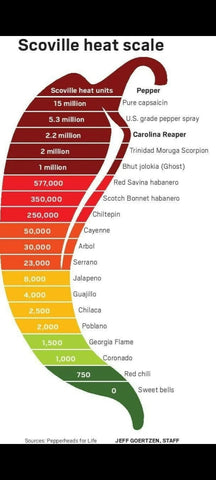The Scoville Scale: A Guide to Understanding Pepper Heat Levels
The Scoville Scale is a measurement of the heat of chili peppers or anything else that contains capsaicin. Capsaicin is the active ingredient that produces the burning sensation in your mouth when you eat spicy food. The Scoville Scale was invented in 1912 by Wilbur Scoville and is named after him.
The original method for measuring the heat of a chili pepper was to grind it up and then dilute it in sugar water until the “heat” was no longer detectable. This method is not very accurate because it is subjective. Today, the more accurate high-performance liquid chromatography (HPLC) test is used. The HPLC test measures the amount of capsaicinoids present in a sample. Capsaicinoids are the chemicals that produce the heat in chili peppers. The results of this test are given in parts per million (ppm).
The Scoville Scale ranges from 0 – 16,000,000 units. The scale starts at 0 because there are some chili peppers that have no capsaicinoids and are therefore not hot. Sweet bell peppers, for example, have a value of 0 on the Scoville Scale. At the other end of the scale are super-hot chili peppers like the Carolina Reaper which has a value of 2,200,000 – 2,800,000 units.
How Hot Is Your Chili Pepper?
Let’s take a look at some common chili peppers and where they fall on the Scoville Scale:

- Bell pepper - 0 units
- Pimento - 100-500 units
- Jalapeño pepper – 2,500 – 8,000 units
- Serrano pepper – 10,000 – 23,000 units
- Cayenne pepper – 30,000 – 50,000 units
- Habanero pepper – 100,000 – 350,000 units
- Thai chili pepper – 50,000 – 100,00 units
- Ghost chili pepper – 1,041,427 units
- Carolina Reaper – 2,200,000 – 2,800,00 units
As you can see from this chart, there is quite a range in heat levels! As you move up the scale, you will notice that the chili peppers get exponentially hotter. So if you’re looking for some spice in your life, be sure to choose your chili pepper wisely!
To give you an idea, bell peppers are often used as a "cooling agent" in dishes that are too spicy for some people to handle. On the other hand, Carolina Reapers are so hot that they are used in law enforcement and military training simulations as a non-lethal way to subdue individuals. In other words, if you're looking for a little bit of heat in your food, you'll want to go with something closer to a bell pepper on the Scoville Scale. But if you're looking to clear out your sinuses (or subdue a training target), then you'll want to look for something closer to a Carolina Reaper.
Bell Peppers vs Habanero Pepper
As we mentioned, bell peppers have a rating of zero on the Scoville Scale. This means they have no heat at all. Bell peppers are actually fruits that belong to the nightshade family, which also includes tomatoes, potatoes, and eggplants. Bell peppers come in a variety of colors including green, red, yellow, and orange. They're often used as ingredients in salads, soups, and stews.
Habanero peppers have a rating of 350,000-580,000 SHU making them some of the hottest chili peppers around. They're native to the Amazon region but are now grown in many parts of the world including Mexico, Central America, and the United States. Habanero peppers are small but pack a serious punch when it comes to heat. They're often used in hot sauces and can also be dried and ground into powder form.
Chili peppers are a staple ingredient in many cuisines around the world, and their popularity shows no signs of waning anytime soon. Thanks to the Scoville Scale, we can now measure just how hot these little peppers can be!
If you’re feeling really adventurous and whether you like your food mild or fiery hot, there’s definitely a chili pepper out there for you. Just be sure to handle them with care…and maybe wear gloves while cooking with them too…just to be safe!

thanks
Great piece, very informative. Hard to believe that level of heat can be blasted into somebody’s eyes!
Look forward to the next piece.
Great insights, great sauce.
Leave a comment